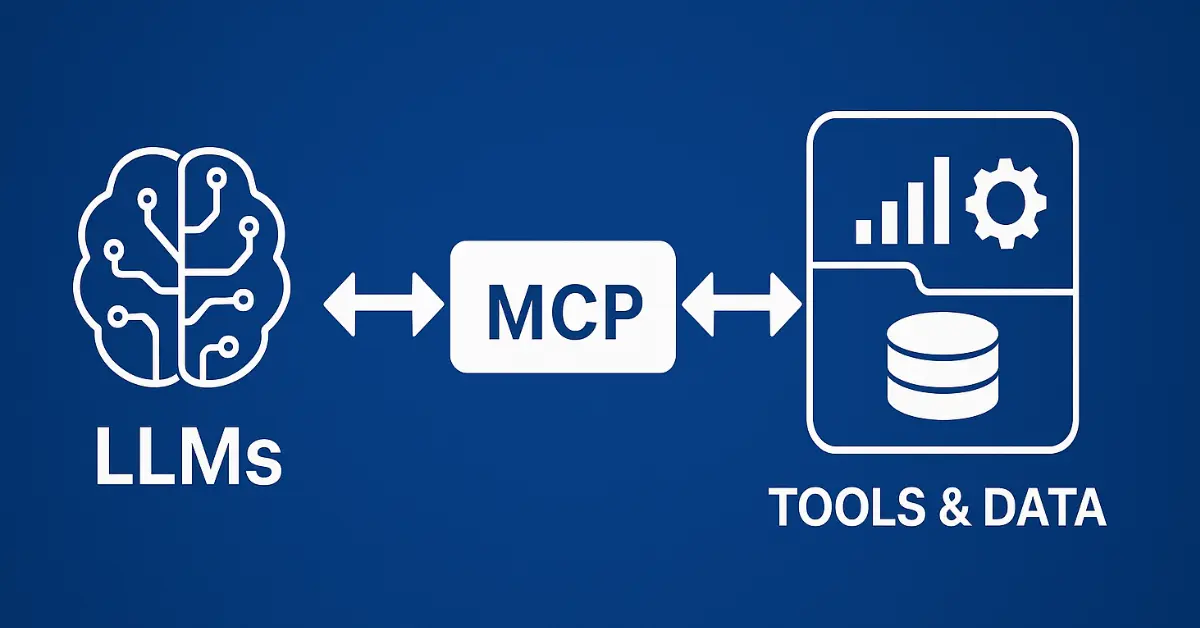The universal go-between for AI, data systems, and tool integration is here.
The AI world moves fast, but amid the endless cycle of overblown nerd hype, one recent development is changing how organizations approach AI strategy.
At the end of 2024, Anthropic created the Model Context Protocol (MCP), revolutionizing how companies connect AI assistants and LLMs to external data sources and perform automated actions.
Adoption has been a little sluggish, but the impact is evident. Without getting too deep in the weeds, we’re going to explore the basics of MCP, and you’ll leave knowing:
- What MCP is and why it matters
- MCP business use cases
- What MCP can do and why you should use it
What Is MCP & Why Does It Matter?
| Model Context Protocol (MCP) is an open-source protocol that standardizes the connection between AI models and external tools, like a universal adapter. |
MCP takes complicated development projects and makes them plug-and-play straight out of the box. It’s hot right now, too, with major players (OpenAI, Microsoft) integrating MCP into their systems.
This development is turning heads because, while LLMs are independently powerful, they’re more powerful when communicating with the proper external data sources and given the power to perform actions. This means an LLM has unfettered access to information a company might store in any number of business intelligence tools and can take actions based on the information stored — think content management systems, customer data platforms, ERPs, CRMs, informing automated actions in those systems.
Before MCP, developers were required to code individual connectors between AI tools and each data source. The process was (and remains) meticulous and required constant upkeep.
MCP removes the need to custom-build these connectors, acting as the aforementioned “universal adapter” to unlimited external data systems and tools.
It saves development time and resources while connecting and educating your AI models on organization-specific data, making AI-generated responses and actions more relevant to your business goals, data types, customer needs, and tool-specific tasks.
Business Use Cases
There’s universal value to a universal connector, but some specific use cases stand out.
- Business Automation: AI agents can seamlessly interact with company databases, analytics tools, and customer relationship management (CRM) systems, enhancing operational efficiency.
- Customer Support: AI-powered assistants can access multiple tools to provide faster and more accurate resolutions to customer inquiries.
- Healthcare: AI models can retrieve and process patient data from various systems, facilitating faster, more accurate healthcare delivery.
- Software Development: Developers can create AI-driven workflows without custom integrations, accelerating development.
MCP in Healthcare
Digging further into the healthcare use case, MCP stands to help deliver astonishing results in an industry notoriously spread thin and needing data centralization. Healthcare has long had numerous different, disconnected systems, and this problem isn’t improving much as time goes on.
These disparate systems isolate patient data, making access more difficult for healthcare providers and their AI tools. MCP is the universal go-between for AI assistants and patient data, regardless of systematic storage. This empowers providers to harness AI to access real-time patient data for quicker clinical decision-making.
Why You Should Use MCP
MCP smoothes the relationship between AI tools, corporate data sources, and end users. These are a few ways MCP is beneficial:
- Save Developer Time: Instead of coding various API connectors from an LLM to numerous different systems, MCP acts as the universal connector.
- Streamline Data Access: Centralized data accessibility empowers users and AI tools to collect and analyze company-wide data, even with siloed data sources.
- Train Smarter AI Models: Rather than relying on prompt engineering, AI tools use broad data access to learn and synthesize company data aligned with organizationally tailored goals.
Action Beyond Access
Data accessibility is cool, but MCP gets much cooler. It does more than act as a bridge; it can power an AI client to actually do work for you.
For instance, Title AI is built on WordPress. The AI client uses MCP to connect to WordPress, Google Analytics, and email, to name a few things. The LLM analyzing everything in the WordPress CMS, GA, and email communications is great, but what’s really great is having the AI client make automated SEO suggestions, website updates, and email sends. Three fewer tasks to do manually, totally powered by MCP.
This only scratches the surface, but the potential to go beyond connection and give AI the power to take prescribed actions based on connected systems is huge.
It’s a big deal because you allow AI to do any necessary tasks. Give it access to your email accounts and use that data to automate responses. Give it access to your project management software and automate task workflows. The point is that MCP doesn’t just let an LLM in the passenger seat; it also lets it drive.
With MCP’s combined access and action pieces, AI’s capabilities are only as limited as your creativity.
MCP Is Here to Stay
There’s plenty of bluster across the tech industry on any given day, but MCP isn’t another fad. Implementation will continue to rise as companies adopt AI tools and realize the business potential of connecting data sources and executing AI-powered actions with minimal friction.

